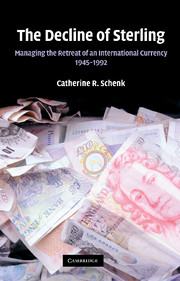Part III - Sterling's Final Retreat 1970–1992
Published online by Cambridge University Press: 04 May 2010
Summary
The decade of the 1970s was a perilous time in the international economy, and it had a profound impact on the retreat of sterling. The period was plagued by destabilising international capital flows that pulled the Bretton Woods system apart in a series of shuddering wrenches. Flexible exchange rates were introduced sporadically from the late 1960s to deal with persistent imbalances, but the general consensus in favour of pegged exchange rates did not begin to falter until the early 1970s. After years of equivocating, in 1971 the US authorities took unilateral action to ameliorate the impact of the international role of the US dollar on their country's balance of payments, in a way that the British government was never powerful enough to do. The rush to accede to American demands shows the political as well as economic commitment to an international monetary system with collective rules. Coming so soon after the failure to find multilateral ways to reform the system, the outcome was another collaborative short-term scheme that was, in the end, insufficient to restore the confidence and flexibility required by international financial markets. The Smithsonian Agreement did, however, succeed in bringing Japan belatedly to its rightful place as a crucial player in the system, commensurate with its commercial influence in its region and beyond.
- Type
- Chapter
- Information
- The Decline of SterlingManaging the Retreat of an International Currency, 1945–1992, pp. 315 - 316Publisher: Cambridge University PressPrint publication year: 2010



